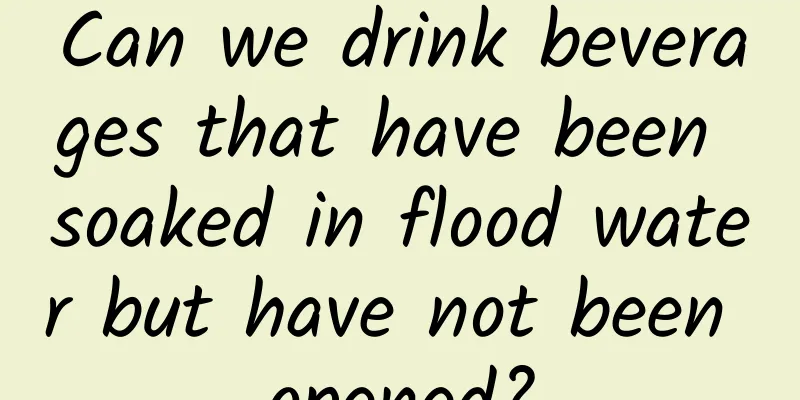Can we drink beverages that have been soaked in flood water but have not been opened?

|
Produced by: Science Popularization China Author: Shi Wuyao (PhD in Biology) Producer: China Science Expo In recent years, extreme weather events have become more frequent, stronger, and more widespread. Recently, heavy rains have occurred in many places, causing waterlogging and flooding disasters. Many supermarkets and restaurants have been flooded or flooded, and beverages and bottled water stored in the stores have also been "disaster-stricken." Topics such as #Don't drink beverages soaked in unhygienic water# are very popular on the Internet. We can't help but ask: Can these beverages soaked in floods or accumulated water still be safely consumed? Beverage packaging and sealing principle (Photo source: Guangming Online) Currently, beverages sold on the market are mostly packaged in plastic bottles, glass bottles, aluminum cans, paper boxes, cans, etc. If we want to understand whether beverages soaked in floods can be consumed safely, we first need to understand the packaging and sealing principles of beverages. Plastic bottles Polyethylene terephthalate (PET) is a widely used plastic material. It is very suitable for beverage packaging due to its high transparency, light weight, drop resistance, and easy processing. PET plastic bottles are usually used with plastic screw caps. The bottle cap and the bottle mouth cooperate with each other through the threaded structure. When the bottle cap is tightened, friction is generated by rotating and tightening to ensure that the bottle cap is firmly fixed on the bottle mouth. Glass Bottle Glass bottles are also commonly used for beverage packaging because of their high chemical stability, no reaction with beverages, and strong recyclability. Glass bottles are sealed with metal caps or stoppers to effectively prevent the entry of external gases and humidity. Metal caps usually have a threaded structure and are sealed by rotating and tightening. Stoppers may be made of materials such as rubber or silicone to increase sealing. Carton packaging Carton packaging is usually composed of paperboard and multi-layer composite materials with good barrier and compression resistance. The carton packaging seals the beverage inside by folding, gluing or heat sealing. Some carton packaging also uses metal layers such as aluminum foil to increase barrier properties. Cans Cans are usually made of aluminum or tinplate, which have good corrosion resistance and barrier properties. The can lid is tightly combined with the can body through the crimping process to form a seal. The inside of the can lid is usually coated with a protective layer to prevent direct contact with the beverage. There are various types of beverage packaging on the market now. When beverages are placed normally, compliant packaging can effectively prevent oxygen and moisture in the air from entering the packaging, thereby avoiding contamination of the beverages. (Photo source: veer photo gallery) How flood water contaminates beverages Floods are a special phenomenon. They carry a large amount of sediment, and may also carry various pollutants such as domestic garbage, pesticides, fertilizers, industrial wastewater, etc. Therefore, floods contain a large number of bacteria, viruses and other microorganisms, which are extremely destructive and polluting. When flood water contacts a beverage bottle, it will automatically flow through narrow spaces such as the bottle thread without any external force. This phenomenon is called capillary action. When the cohesive force of the liquid in the narrow space such as the bottle thread, that is, the surface tension of the liquid and the adhesion between the liquid and the container wall work together, it will push the liquid to flow, causing pollutants in the flood water to enter the bottle. In addition, dirt in the flood water may adhere to the packaging surface, especially on the threads of the bottle cap and bottle mouth. Even if the beverage in the bottle itself is not contaminated, these dirt may be brought into the bottle when the bottle cap is opened. It can be seen that when flood water submerges warehouses or supermarkets where beverages are stored, even sealed beverages may be contaminated. Floods carry garbage (Photo source: veer photo gallery) How can drinks be contaminated by flood water without leaking? Beverage bottle caps are mainly composed of threads, sealing rings and anti-theft rings. These three key components are carefully designed to ensure that there is no air leakage. First, the internal thread of the bottle cap and the external thread of the bottle mouth must be precisely matched to form a tight threaded connection. This match generates friction through extrusion to ensure that the bottle cap is firmly fixed on the bottle mouth. The radial matching clearance of the internal and external threads must be controlled within a certain range to prevent them from easily rotating or loosening. In addition, a sealing ring is usually installed inside the bottle mouth to expand the sealing area. The radius of its extended part is larger than the bottom radius, and the end is designed with an appropriate curvature, which helps to fit more closely to the inside of the bottle mouth and achieve a better sealing effect. The anti-theft ring also enhances the sealing performance of the bottle cap to a certain extent. When the bottle cap is tightened, the anti-theft ring fits tightly with the bottle cap and the bottle mouth to form an additional sealing layer. It can be seen that the bottle cap ensures that the beverage bottle does not leak during transportation, storage and use through comprehensive consideration and fine design of thread matching, sealing ring design, anti-theft ring design and other aspects. Plastic bottles (Photo source: veer photo gallery) Don't take floods lightly After a flood, several aspects should be taken care of to ensure personal safety, reduce property damage, and prevent the spread of disease. Personal safety Avoid deep water areas, places with fast currents, and avoid wading, especially in unfamiliar areas, to avoid hidden traps. If you encounter difficulties, contact rescue agencies as soon as possible and do not try to take risks alone to avoid aggravating the danger. Rescue workers (Photo source: veer photo gallery) Food and hygiene safety Floods may cause food to spoil, livestock to become sick or die, etc. Therefore, do not eat food soaked in floods, and do not drink untreated surface water, rainwater, or flood water directly. If the water supply system is affected by floods, make sure the water source is safe and uncontaminated before reusing it. If necessary, test the water quality. Try to choose bottled water, barreled water and emergency water that have not been soaked by floods. If conditions do not allow, boil the water before drinking. At the same time, the utensils used for cooking should be cleaned and disinfected before use. Food mold (Photo source: veer photo gallery) Residential safety Check your home for damage. If you find any problems with the structure or a leaking roof, seek professional help as soon as possible. If there is water inside the home, avoid using electrical appliances to avoid electric shock. Do not plug in electrical equipment until you are sure there is no problem. Electrical safety (Photo source: veer photo gallery) In short, we need to remain highly vigilant and cautious when floods rage. Drinks and other materials soaked or washed by floods must be carefully identified and handled, and never drunk or eaten blindly. Only by comprehensively considering and taking appropriate measures can we effectively cope with the challenges brought by flood disasters. References: 1. Xiang Bin. Analysis on the safety of PET plastic bottles[J]. China Packaging, 2010, 30(9):2. 2. Zhang Rui, Li Lan. Analysis of bottled water packaging design[J]. Packaging Engineering, 2014, 35(14):5. 3. Yu Qian, Li Na, Wang Yanyan, et al. Construction and research of ecological and environmental impact assessment system of flood pollution[J]. Journal of China Institute of Water Resources and Hydropower Research, 2019, 17(4):6. 4. Guo Zicheng, Luo Qingzhi. Thermodynamic description of wetting and capillary phenomena[J]. University Physics, 2000, 19(6):19-19. |
<<: Do you think the "cracking" sound in the joints comes from the bones? | Illustrated Science
>>: How many steps are there to trim an elephant's feet?
Recommend
Does Huang Xiaoming’s Nut Projector P1 have the same looks as Angelababy?
Last month, the JMGO Projector P1, invested by St...
The top ten car brands with the lowest engine failure rate are released: BMW and Audi are out of the list, and the Civic ranks first
The automotive industry has the habit of selectin...
Samsung's self-driving technology may have surpassed Apple and is targeting Google
Since 2012, the most fascinating and heart-wrench...
Traditional TV industry changes and seeks help from Internet targeted advertising
The TV market is fragmented, and the main selling...
Advertising case study: how to reduce the cost of leads by 50%?
Today I would like to share with you a case study...
How to use data to drive operational growth
Maybe we won’t get a satisfactory result immediat...
How to become a global energy storage company in less than 6 years? Ruipu Lanjun gives an innovative answer
The development of the energy storage market this...
The product logic and marketing strategy behind emerging brands
At present, emerging brands are developing at an ...
In-depth study of Android Dalvik's Dex file format
Case Studies In this case study, we will examine ...
Case analysis: The entire process of Xiaohongshu product operation and promotion!
1. Analyze the product The first step in promotio...
How to write heartfelt copywriting in 3 steps?
Nowadays, if you don’t have any copywriting skill...
Zhou Bangqin English Thinking Training Camp
Zhou Bangqin's English Thinking Training Camp...
Liu Bing: How many unique plants are born in the magical Madagascar?
“On this island, we can see seven species of baob...
Ah? This pavilion can make it rain by itself?
Did you know that there is an interesting pavilio...
Huawei files lawsuit against FCC, alleging it violates U.S. Constitution
[[284776]] On December 5, Huawei's Shenzhen h...









